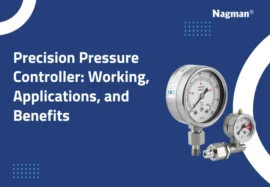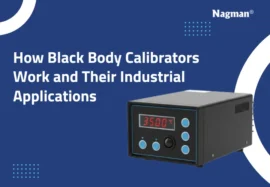Different industries, including engineering, manufacturing, research, and healthcare, depend on various tools for their operations. Various test and measuring instruments are also used, requiring periodic calibration to maintain their reliability and precision.
This blog examines twelve measuring instruments and discusses their industrial applications and significance.
Electrical and Electronic Measuring Equipment
1. Precision Thermometer
Use: Measures temperature with high accuracy.
This tool serves many purposes in laboratory work as well as industrial and meteorological settings.
2. Dual Input Humidity Temperature Meter
Use: Measures both humidity and temperature simultaneously.
This device is required by HVAC (Heating, Ventilation, and Air Conditioning) systems, clean rooms, and weather monitoring stations. For best results, ensure that measuring devices are regularly calibrated.
3. Four-Channel Data Logger Thermometer
Use: Records temperature data over time through four different input channels.
The combination thermometer serves pharmaceuticals, food storage, and climate research by tracking temperature shifts for safety standard compliance.
4. Data Logger Temperature Humidity Recorder
Use: Stores temperature and humidity readings for later analysis.
This device serves warehouses, greenhouses, and transportation businesses by preserving suitable environmental conditions for valuable products.
5. Sound Level Meter
Use: This device measures noise intensity through the dB scale.
This device helps detect noise levels to support environmental noise monitoring, workplace safety, and audio engineering compliance with regulations.
6. Datalogger Sound Level Meter
Use: The device records and saves noise measurements over an extended duration.
Sound Level Meters serve multiple functions in noise assessment for industrial environments, urban development projects, and workplace sound level management.
7. Ultrasonic Thickness Gauge
Use: This device determines material thickness through ultrasonic wave analysis.
The tool finds extensive applications in construction, along with aviation and pipeline investigations, to identify corrosion and wear phenomena.
8. LED Light Meter
Use: Measures the intensity of light in lux or foot candles.
The device serves essential functions for photography and cinematography and helps organisations meet workplace lighting standards.
9. TRMS AC/DC Clamp Meter
Use: This device measures AC/DC voltage, current, and resistance.
The combination of electricians and engineers relies on these test and measuring instruments to solve electrical problems while maintaining residential and industrial power systems.
10. Insulation Tester
Use: Tests insulation resistance in electrical systems.
Insulation test devices protect against electrical threats by verifying insulation material efficiency, and they are used in power plants, construction sites, and maintenance crews.
11. Earth Resistance Tester
Use: The device evaluates grounding system resistances.
Power stations and electrical installations use Earth Resistance Testers to establish proper grounding, which reduces the risks of electrical failure and potential hazards.
12. Carbon Monoxide (CO) Meter
Use: This device identifies the presence of carbon monoxide throughout the environment.
Industrial safety, workplace compliance, and home safety rely on this critical tool to prevent carbon monoxide poisoning.
Proper Use and Maintenance of Measuring Instruments
Testing equipment functions best when users maintain correct operation and perform proper instrument upkeep. Follow these best practices:
- Use the Right Tool: The tool should never be used for functions beyond what the manufacturer intended.
- Handle with Care. Rough handling can affect accuracy. All measuring instruments must be stored in protective cases when not in use.
- Regular Calibration: Calibration of measuring devices ensures consistent and precise readings.
- Keep Clean & Dry: The exposure to both moisture and dust causes harm to delicate internal components.
- Follow Manufacturer Guidelines: Follow the manufacturer-specified maintenance procedures to reach their maximum lifetime.
These steps will help reduce wear and tear and ensure your equipment will last longer.
Importance of Calibration in Measuring Instruments
The operation of many industries depends on calibration test bench manufacturers to verify that their instruments reach the necessary standards. Calibrating devices helps:
- Improve measurement precision
- Maintained compliance with safety regulations.
- Prevents equipment breakdowns
- Reduces expensive operational errors
Conclusion
Proper testing and measuring equipment is crucial for industrial operation accuracy, efficiency, and safety. Technological progress has improved tools by enhancing their intelligence and precision while simplifying their operation. The achievement of accurate results depends heavily on the expertise of calibration test bench manufacturers like us, who can calibrate your desired instrument to its highest accuracy.






